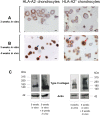Evaluation of the biocompatibility and stability of allogeneic tissue-engineered cartilage in humanized mice
- PMID: 31107916
- PMCID: PMC6527235
- DOI: 10.1371/journal.pone.0217183
Evaluation of the biocompatibility and stability of allogeneic tissue-engineered cartilage in humanized mice
Abstract
Articular cartilage (AC) has poor capacities of regeneration and lesions often lead to osteoarthritis. Current AC reconstruction implies autologous chondrocyte implantation which requires tissue sampling and grafting. An alternative approach would be to use scaffolds containing off-the-shelf allogeneic human articular chondrocytes (HACs). To investigate tolerance of allogeneic HACs by the human immune system, we developed a humanized mouse model implanted with allogeneic cartilage constructs generated in vitro. A prerequisite of the study was to identify a scaffold that would not provoke inflammatory reaction in host. Therefore, we first compared the response of hu-mice to two biomaterials used in regenerative medicine, collagen sponge and agarose hydrogel. Four weeks after implantation in hu-mice, acellular collagen sponges, but not acellular agarose hydrogels, showed positive staining for CD3 (T lymphocytes) and CD68 (macrophages), suggesting that collagen scaffold elicits weak inflammatory reaction. These data led us to deepen our evaluation of the biocompatibility of allogeneic tissue-engineered cartilage by using agarose as scaffold. Agarose hydrogels were combined with allogeneic HACs to reconstruct cartilage in vitro. Particular attention was paid to HLA-A2 compatibility between HACs to be grafted and immune human cells of hu-mice: HLA-A2+ or HLA-A2- HACs agarose hydrogels were cultured in the presence of a chondrogenic cocktail and implanted in HLA-A2+ hu-mice. After four weeks implantation and regardless of the HLA-A2 phenotype, chondrocytes were well-differentiated and produced cartilage matrix in agarose. In addition, no sign of T-cell or macrophage infiltration was seen in the cartilaginous constructs and no significant increase in subpopulations of T lymphocytes and monocytes was detected in peripheral blood and spleen. We show for the first time that humanized mouse represents a useful model to investigate human immune responsiveness to tissue-engineered cartilage and our data together indicate that allogeneic cartilage constructs can be suitable for cartilage engineering.
Conflict of interest statement
The authors have declared that no competing interests exist.
Figures






References
-
- Görtz S and Bugbee WD. Allografts in articular cartilage repair. J Bone Joint Surg Am. 2006;88: 1374–1384. - PubMed
-
- Langer F and Gross AE. Immunogenicity of allograft articular cartilage. J Bone Joint Surg Am. 1974;56: 297–304. - PubMed
-
- Malejczyk J, Osiecka A, Hyc A, Moskalewski S. Effect of immunosuppression on rejection of cartilage formed by transplanted allogeneic rib chondrocytes in mice. Clin Orthop Relat Res. 1991;269: 266–273. - PubMed
-
- Kawabe N and Yoshinao M. The repair of full-thickness articular cartilage defects. Immune responses to reparative tissue formed by allogeneic growth plate chondrocyte implants. Clin Orthop Relat Res. 1991;268: 279–293. - PubMed
Publication types
MeSH terms
LinkOut - more resources
Full Text Sources
Other Literature Sources
Medical
Research Materials

